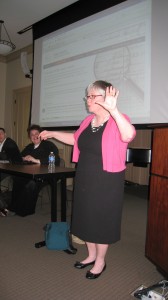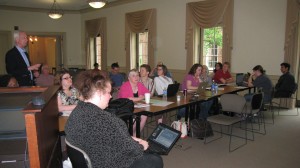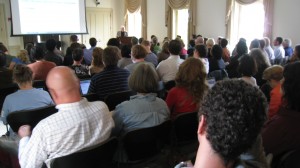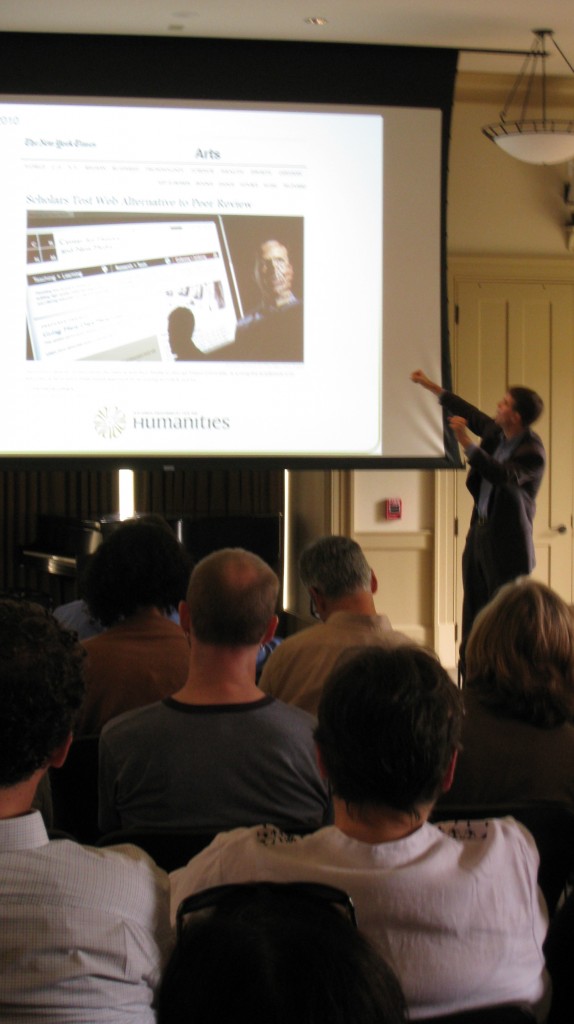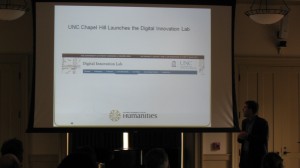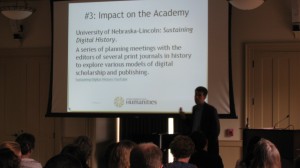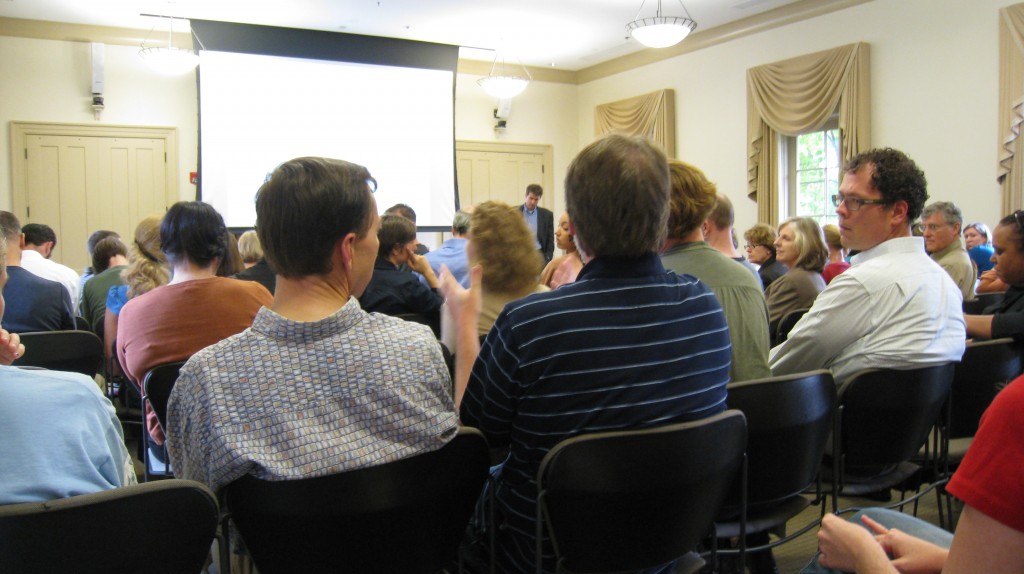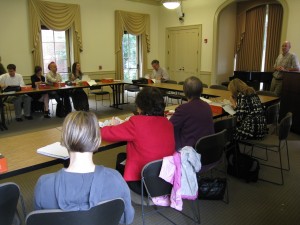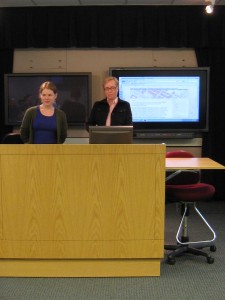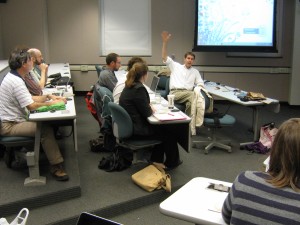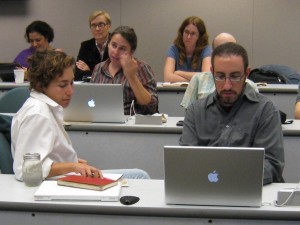On Tuesday, March 24th, the Digital Innovation Lab, the UNC Libraries, and the Odum Institute for Research in Social Sciences co-sponsored a symposium to explore research, teaching, and engaged scholarship applications of the North Carolina digitized newspaper collection. The symposium took place in the Pleasants Family Assembly Room in Wilson Library on the UNC campus and was attended by more than 50 scholars from departments across the humanities and social sciences.
UNC scholars now have access to over 3.3 million pages of historical newspapers dating from the 1750s through the 1920s, digitized through a partnership between the UNC Libraries and Newspapers.com (a division of Ancestry.com). The scale and diversity of the newspaper collection prompted scholars from the DIL, the Libraries, and the Odum Institute to ask, “What can you do with 3 million pages of digitized North Carolina newspapers?” The symposium provided an opportunity to think through this question, with scholars from UNC Chapel Hill, NC State, and Northeastern University offering examples of how the availability of digitized historical newspapers has transformed their teaching and research.
 The symposium began with a welcome from Dr. Robert Allen, Professor of American Studies at UNC Chapel Hill and Director of the Digital Innovation Lab. Ashley Reed, Postdoctoral Fellow with the Carolina Digital Humanities Initiative, then offered an introduction to the newspaper interface designed by Newspapers.com for use by UNC scholars. The collection can be reached by any UNC scholar with an Onyen: visit library.unc.edu and type “newspapers.com” in the “Search” field at the center of the page. The interface offers advanced searching and browsing capabilities, including allowing users to narrow their searches by date range or geographic area.
The symposium began with a welcome from Dr. Robert Allen, Professor of American Studies at UNC Chapel Hill and Director of the Digital Innovation Lab. Ashley Reed, Postdoctoral Fellow with the Carolina Digital Humanities Initiative, then offered an introduction to the newspaper interface designed by Newspapers.com for use by UNC scholars. The collection can be reached by any UNC scholar with an Onyen: visit library.unc.edu and type “newspapers.com” in the “Search” field at the center of the page. The interface offers advanced searching and browsing capabilities, including allowing users to narrow their searches by date range or geographic area.
Once attendees had been introduced to the Newspapers.com interface, Nicholas Graham, Program Coordinator for the North Carolina Digital Heritage Center, and Krista Hegerhorst, Head of Institutional Partnerships for Newspapers.com, offered a short history of the partnership between the UNC Libraries and Newspapers.com and discussed how it might serve as a model for other public-private partnerships that might help to make historical and cultural materials more widely available. Graham emphasized the scale of UNC’s newspaper collections on microfilm and noted that without the Newspapers.com partnership it would have been difficult to make these materials available in digital form. Hegerhorst noted how quickly the digitized materials have been adopted by Newspapers.com subscribers and the UNC community, with almost 200 new users accessing the collection each month.
 The next portion of the program offered examples of how these newly digitized North Carolina newspapers have already begun transforming research and teaching in the Triangle. Dr. Robert Allen detailed how students in his first-year American Studies seminars have used the newspapers to supplement their reading of scholarly texts including Heather Williams’ Help Me To Find My People and Catherine Bishir’s Crafting Lives: African American Artisans in New Bern, North Carolina, 1770-1900. Using the North Carolina newspapers and the larger Ancestry.com archives, students are able to extend the personal stories told in these scholarly works and to put human faces on historical subjects. Next Catherine Bishir herself, Curator in Architectural Special Collections at North Carolina State University Libraries, detailed how the North Carolina newspapers have allowed her to exponentially expand the information available in North Carolina Architects and Builders (ncarchitects.lib.ncsu.edu), an ongoing online biographical dictionary for which she serves as editor-in-chief. Bishir noted that often the most reliable information about the architectural history of a city can be found in the newspapers of neighboring cities, where political loyalties hold less sway and information is sometimes more accurate.
The next portion of the program offered examples of how these newly digitized North Carolina newspapers have already begun transforming research and teaching in the Triangle. Dr. Robert Allen detailed how students in his first-year American Studies seminars have used the newspapers to supplement their reading of scholarly texts including Heather Williams’ Help Me To Find My People and Catherine Bishir’s Crafting Lives: African American Artisans in New Bern, North Carolina, 1770-1900. Using the North Carolina newspapers and the larger Ancestry.com archives, students are able to extend the personal stories told in these scholarly works and to put human faces on historical subjects. Next Catherine Bishir herself, Curator in Architectural Special Collections at North Carolina State University Libraries, detailed how the North Carolina newspapers have allowed her to exponentially expand the information available in North Carolina Architects and Builders (ncarchitects.lib.ncsu.edu), an ongoing online biographical dictionary for which she serves as editor-in-chief. Bishir noted that often the most reliable information about the architectural history of a city can be found in the newspapers of neighboring cities, where political loyalties hold less sway and information is sometimes more accurate.
 Finally, Thomas Carsey, Professor of Political Science at UNC Chapel Hill and Director of the Odum Institute, offered a vision of possibilities for big-data social science research using the North Carolina digitized newspaper collection. In addition to providing a web interface for searching and browsing the digitized newspaper collection, Newspapers.com is providing to the UNC Libraries all of the raw data created during the digitization process, including JPEG, PDF, and XML files. The availability of over 3.3 million digital files containing machine-transcribed text will offer nearly limitless possibilities for historical data mining and large-scale textual analysis projects. Carsey encouraged scholars with such projects in mind to contact the Digital Innovation Lab or the Odum Institute for consultation.
Finally, Thomas Carsey, Professor of Political Science at UNC Chapel Hill and Director of the Odum Institute, offered a vision of possibilities for big-data social science research using the North Carolina digitized newspaper collection. In addition to providing a web interface for searching and browsing the digitized newspaper collection, Newspapers.com is providing to the UNC Libraries all of the raw data created during the digitization process, including JPEG, PDF, and XML files. The availability of over 3.3 million digital files containing machine-transcribed text will offer nearly limitless possibilities for historical data mining and large-scale textual analysis projects. Carsey encouraged scholars with such projects in mind to contact the Digital Innovation Lab or the Odum Institute for consultation.
 Following this panel the event’s keynote speaker, Dr. Ryan Cordell of Northeastern University, offered one example of how the computational analysis of millions of newspaper pages can offer a window into the past. Cordell is co-director, with Elizabeth Maddock Dillon and David Smith, of the Viral Texts project, which mines the Library of Congress’s Chronicling America database and other large-scale digitized newspaper collections to determine which texts—political, literary, informational—circulated most widely in nineteenth-century newspapers. Cordell and his interdisciplinary team of faculty, graduate students, and undergraduates use a combination of algorithms to seek matching phrases across the entire Chronicling America digital corpus. These algorithms return “clusters” of similar texts, providing the project team with an idea of how news items circulated and which texts were most likely to “go viral” in the nineteenth-century United States. Such analysis would be impossible for even a large team of human scholars to perform without the assistance of computational methodologies, and the results are relevant to disciplines ranging from literary studies to political science to history to public health. After a lively and informative question and answer session, attendees adjourned to Wilson Library to enjoy a reception generously sponsored by the Odum Institute.
Following this panel the event’s keynote speaker, Dr. Ryan Cordell of Northeastern University, offered one example of how the computational analysis of millions of newspaper pages can offer a window into the past. Cordell is co-director, with Elizabeth Maddock Dillon and David Smith, of the Viral Texts project, which mines the Library of Congress’s Chronicling America database and other large-scale digitized newspaper collections to determine which texts—political, literary, informational—circulated most widely in nineteenth-century newspapers. Cordell and his interdisciplinary team of faculty, graduate students, and undergraduates use a combination of algorithms to seek matching phrases across the entire Chronicling America digital corpus. These algorithms return “clusters” of similar texts, providing the project team with an idea of how news items circulated and which texts were most likely to “go viral” in the nineteenth-century United States. Such analysis would be impossible for even a large team of human scholars to perform without the assistance of computational methodologies, and the results are relevant to disciplines ranging from literary studies to political science to history to public health. After a lively and informative question and answer session, attendees adjourned to Wilson Library to enjoy a reception generously sponsored by the Odum Institute.
Faculty, staff, and graduate students who were unable to attend the symposium but wish to explore uses of the newspaper collection in their research and teaching are encouraged to contact the event’s organizer, Ashley Reed (reeda (at) email.unc.edu), to discuss potential projects.
The University Gazette published an article on the digital collection and the symposium event in its online issue for March 31, 2015.






